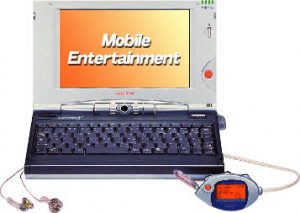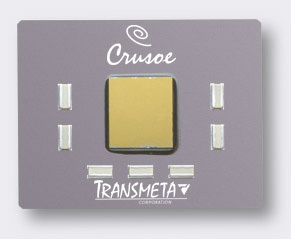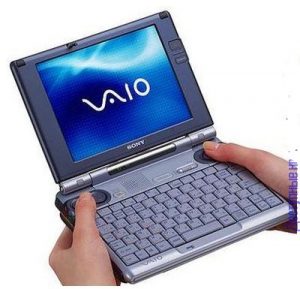In the previous article we already talked about the MiniNotes of the 1990s – Toshiba ended their classic Libretto series outside of Japan in 1999, but in Japan they released new model – the “ff” and “ss” series which were technically rather unimpressive, but it should be noted that the FF1100 from late 1999 was probably one of the first netbooks to feature a built-in camera (A webcam as we would say today).

The year 2000 started without many surprises. For a moment it seemed the MiniNote market was saturated. It wasn’t until late 2000 that a new challenger appeared. Fujitsu had been manufacturing rather uninspiring notebooks under the “FMV Biblo” brand name. I don’t know if this is a mis-translation of “biblio”(From the greek “Biblion” meaning “book”) or some clever naming scheme i just haven’t gotten yet – but their first Biblo were rather dull notebooks for the mass market. However – on september 2000 they introduced the FMV Biblo “Loox”. Notably the big “T Series” with 10 inch screen which is less interesting for us MiniNote geeks, but also the famous “S Series” which came with a 8.8 inch screen and was closer to the original MiniNote form factor. To be precise the “FMV Biblo Loox S5/53” – or “FMV Biblo Loox S5/53W”. The “W” includes an obscure Japanese ISDN style modem that isn’t compatible with anything in the rest of the world, so if you lack the “W” you didn’t really miss much. At 243 x 151 x 30 mm this was a bit larger than the Toshiba Libretto 100 series, but for these few milimeters more you actually got a really interesting machine that addressed some issues with previous MiniNotes.

Since the Libretto 20 the processor speed has more than tripled and additional stuff like modems and better graphics cards were added. However – battery life was not really improving, so besides ridiculously oversized batteries the most sold accessories were additional batteries – it was not uncommon that a Japanese businessman was carrying around one or more additional batteries in his suitcase. The Biblo Loox introduced the “Transmeta Crusoe” – a new type of processor that was built to be really power saving and would somewhat dominate the market of ultra-portables for the next few years. In a time before Intel Atom that was for sure a difference. So the Loox offered around 3.6 hours of battery type with the small battery and up to 8 hours with the large battery. Back in the year 2000 reading “8 hours of battery life” was jaw dropping for most Japanese that got used to carrying around an armada of spare batteries. But also the rest of the specs were nice. The screen offered a rather unique res of a whooping 1024 x 512. The graphics card was an ATI Rage Mobility-M – making it the first MiniNote with a “real” 3D graphics card. Memory was a whooping 128MB (Where 16MB were used for the Transmeta Processor code morphing function). HDD came with 10GB capacity which was also a lot in the days. USB, PCMCIA and modem included. 980 gram also made it rather lightweight, just under the magic 1 Kg barrier. This was really a breakthrough which immediately made it a best-seller. Not everyone loved the Crusoe – performance was slower than with the typical Intel processor, so a 933 MHz Crusoe “performed” more like an Intel processor with half that speed in Windows XP. The Crusoe used a quite unique “Code morphing” technology actually transforming X86 code into it’s own crude logic “On the fly” – so it was rather “emulating” an X86 CPU. In theory it would even have been possible to emulate other processors like 68K or ARM, but it was never delivered with anything else but the X86 emulation. The code morphing also had the drawback that it consumed a little bit (Somewhere in the range between 10 and 20 MB) RAM to park the code morphing stuff.

So it wouldn’t take too long until the competition reacted…
In 2001 Toshiba introduced the “Libretto L1” which received mixed reviews. Generally not a bad device, but the form factor had grown by 5 centimeter in each direction (Albeit being thinner) kinda eliminating the compact size the Libretto was famous for. So Size-wise it was now more of a subnotebook and while still being considerably small and technically impressive it failed to win the hearts of all the Japanese customers wanting another “MiniNote”
Sony released the PG-U1 in April 2002.

While it wouldn’t look so impressive like 15 years later this was quite a sensation in 2002… Really tiny form factor that gets me close to calling it a “Palmtop”, 1024 x 768 on a 6.4 inch screen means like 200 Pixel per inch. That is an impressive pixel per inch density that was incredibly impressive back in the days. More than 10 years later Apple was selling their Laptops with a “retina display” which had just reached the level Sony defined like a decade earlier, being around 200-220 PPI. The 866 MHz Transmeta processor also allowed impressive power saving – boosting battery like to around 4.5 hours with normal office appz. And since Sony always longed for more they offered the notorious extended battery (Which was nearly the same dimensions as the actual notebook) that could snap into the bottom of the device – delivering breathtaking unreal 9 hours of battery life. USB, Ethernet, Firewire (Called “i.Link” by Sony), PCMCIA and the notorious MemoryStick slot included. 128 MB BAse RAM, upgradable to a max of 384MB (Minus a bit that the gfx card and transmeta processor consume).
There was also the PCG-U3 – a special “Online order only” edition – which only differed slightly by a black case (Instead of the U1 silver), the “faster” 933 MHz Transmeta Crusoe (Like you’d ever notice the additional 60 MHz) and more base RAM (256MB instead of 128 MB)
In 2003 Sony reacted to some complaints about the “sluggish” performance of the U-Series and trashed the Transmeta concept, going back to Intel processors. So the U101 of 2003 used an Intel Celeron with 600MHz – which notably performed much better than the 933 MHz Crusoe.
…more to come